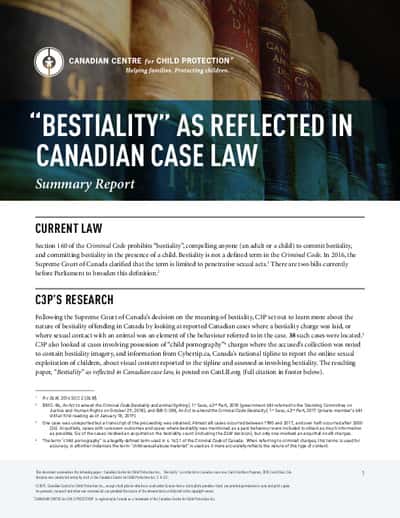A close look at the circumstances surrounding known instances of bestiality helps to shine a light on a topic that has been largely hidden in the shadows, and raises important issues for consideration by all those involved in the criminal justice system and risk management.
“Bestiality” As Reflected in Canadian Case Law
In 2016, the Supreme Court of Canada issued a decision clarifying that the term “bestiality,” in the context of section 160 of the Criminal Code, captures only “penetrative” sexual acts involving a human and an animal.1 Recognizing that the bestiality offence plays an important role in prohibiting sexual acts that involve animals and children, C3P set out to learn more about the nature of bestiality offending in Canada by looking at past legal decisions and information from Cybertip.ca.
The resulting paper, “Bestiality” as reflected in Canadian case law, is helping to shine light on a topic that has been largely hidden in the shadows. The report contains information about 38 reported Canadian cases involving an act (or alleged act) of bestiality, 47 cases involving visual content depicting bestiality, and 167 images or videos reported to Cybertip.ca and assessed as involving bestiality. Many of the cases reviewed involved horrifying situations of sustained offending against both human and animal victims. While the goal was not to bring together some of the worst cases of extended sexual abuse in Canada, that has been the unintended outcome.
The frequency with which the abuse of animal and human victims, particularly children, overlapped within the cases reviewed suggests there is a need to examine the adequacy of not only existing laws, but also the systems in place to manage risk and protect animals and people who are vulnerable to being victimized.
It was immediately apparent from reviewing the cases that many individuals who were willing to victimize an animal, were also willing to victimize a child. In fact, for 82% (31 out of 38) of the cases that involved bestiality activity, the sexual abuse of a child (or children) occurred as frequently as, if not more frequently than, the coerced sexual activity involving an animal.
Learn More About Our Observations
Read the full paper on CanLII.org .
Recommendations for Action
In June 2019, a Bill broadening the definition of bestiality to capture all sexual activity between an animal and a human received Royal Assent and is now law.2 The Bill also enables a court to limit an individual’s access to animals if convicted of a bestiality offence, and now individuals convicted of any form of bestiality are required to register as a sex offender.3
C3P has the following additional recommendations for action:
- Expressly make visual content depicting bestiality illegal.
- Enhance data collection to accurately capture all instances where an animal is abused for a sexual purpose.
- Promote cross-reporting between animal and child protection agencies.4
- Consider adding questions about animal sexual abuse to common risk assessment tools used in forensic and therapeutic settings.
- 1 R v DLW, 2016 SCC 22. ↩
- 2 Bill C-84, An Act to amend the Criminal Code (bestiality and animal fighting), 1st Sess, 42nd Parl, assented to June 21, 2019. ↩
- 3 Previously an individual only had to register if they were convicted of bestiality involving a human victim. ↩
- 4 There is support for this recommendation from the Standing Senate Committee on Social Affairs, Science and Technology. In its June 13, 2019 report on Bill C-84, the Committee did not propose any amendments to the Bill, but did make the following observation: “…that the Minister of Justice promote cross-reporting between animal and child protection agencies. As the Canadian Centre for Child Protection noted, this will lead to better detection of the abuse of both children and animals, enabling protective intervention that might not otherwise happen as both types of abuse tend to be very difficult to uncover.” See the Report of the Committee, available online: https://sencanada.ca/en/committees/report/77648/42-1. ↩
